使用ACI多站点交换矩阵配置站点间L3out
下载选项
非歧视性语言
此产品的文档集力求使用非歧视性语言。在本文档集中,非歧视性语言是指不隐含针对年龄、残障、性别、种族身份、族群身份、性取向、社会经济地位和交叉性的歧视的语言。由于产品软件的用户界面中使用的硬编码语言、基于 RFP 文档使用的语言或引用的第三方产品使用的语言,文档中可能无法确保完全使用非歧视性语言。 深入了解思科如何使用包容性语言。
关于此翻译
思科采用人工翻译与机器翻译相结合的方式将此文档翻译成不同语言,希望全球的用户都能通过各自的语言得到支持性的内容。 请注意:即使是最好的机器翻译,其准确度也不及专业翻译人员的水平。 Cisco Systems, Inc. 对于翻译的准确性不承担任何责任,并建议您总是参考英文原始文档(已提供链接)。
目录
简介
本文档介绍使用思科以应用为中心的基础设施(ACI)多站点交换矩阵进行站点间L3out配置的步骤。
先决条件
要求
Cisco 建议您了解以下主题:
- 功能性ACI多站点交换矩阵设置
- 外部路由器/连接
使用的组件
本文档中的信息基于:
-
多站点协调器(MSO)2.2(1)版或更高版本
-
ACI版本4.2(1)或更高版本
- MSO节点
- ACI交换矩阵
- Nexus 9000系列交换机(N9K)(终端主机和L3out外部设备模拟)
- Nexus 9000系列交换机(N9K)(站点间网络(ISN))
本文档中的信息都是基于特定实验室环境中的设备编写的。本文档中使用的所有设备最初均采用原始(默认)配置。如果您的网络处于活动状态,请确保您了解所有命令的潜在影响。
背景信息
站点间L3out配置支持的方案
架构配置1
- 租户在站点(A和B)之间延伸。
- 虚拟路由和转发(VRF)在站点(A和B)之间延伸。
- 一个站点(A)的本地终端组(EPG)/网桥域(BD)。
- L3out本地到另一个站点(B)。
- L3out本地到站点(B)的外部EPG。
- 从MSO创建和配置合同。
架构配置2
- 租户在站点(A和B)之间延伸。
- VRF在站点(A和B)之间延伸。
- EPG/BD在站点(A和B)之间延伸。
- L3out本地到一个站点(B)。
- L3out本地到站点(B)的外部EPG。
- 合同配置可以从MSO完成,或者每个站点都通过应用策略基础设施控制器(APIC)创建本地合同,并在延伸EPG和L3out外部EPG之间本地连接。在这种情况下,由于本地合同关系和策略实施需要影子External_EPG,因此它会出现在站点A。
方案配置3
- 租户在站点(A和B)之间延伸。
- VRF在站点(A和B)之间延伸。
- EPG/BD在站点(A和B)之间延伸。
- L3out本地到一个站点(B)。
- L3out的外部EPG在站点(A和B)之间延伸。
- 合同配置可以从MSO完成,或每个站点都从APIC创建本地合同,并在延伸EPG和延伸外部EPG之间本地连接。
方案配置4
- 租户在站点(A和B)之间延伸。
- VRF在站点(A和B)之间延伸。
- EPG/BD本地到一个站点(A)或EPG/BD本地到每个站点(站点A中的EPG-A和站点B中的EPG-B)。
- L3out本地到一个站点(B),或为了实现外部连接的冗余,您可以将L3out本地到每个站点(本地到站点A,本地到站点B)。
- L3out的外部EPG在站点(A和B)之间延伸。
- 合同配置可以从MSO完成,或每个站点具有从APIC创建的本地合同,并在延伸EPG和延伸外部EPG之间本地连接。
方案配置5(传输路由)
- 租户在站点(A和B)之间延伸。
- VRF在站点(A和B)之间延伸。
- L3out本地到每个站点(本地到站点A和本地到站点B)。
- 每个站点(A和B)的本地外部EPG。
- 合同配置可以从MSO完成,或每个站点具有从APIC创建的本地合同,并在外部EPG本地和影子外部EPG本地之间本地附加。
方案配置5(VRF间传输路由)
- 租户在站点(A和B)之间延伸。
- 本地到每个站点(A和B)的VRF。
- L3out本地到每个站点(本地到站点A和本地到站点B)。
- 每个站点(A和B)的本地外部EPG。
- 合同配置可以从MSO完成,或每个站点具有从APIC创建的本地合同,并在外部EPG本地和影子外部EPG本地之间本地附加。
注意:本文档提供基本站点间L3out配置步骤和验证。在本例中,使用Schema-config1。
配置
网络图
物理拓扑

逻辑拓扑
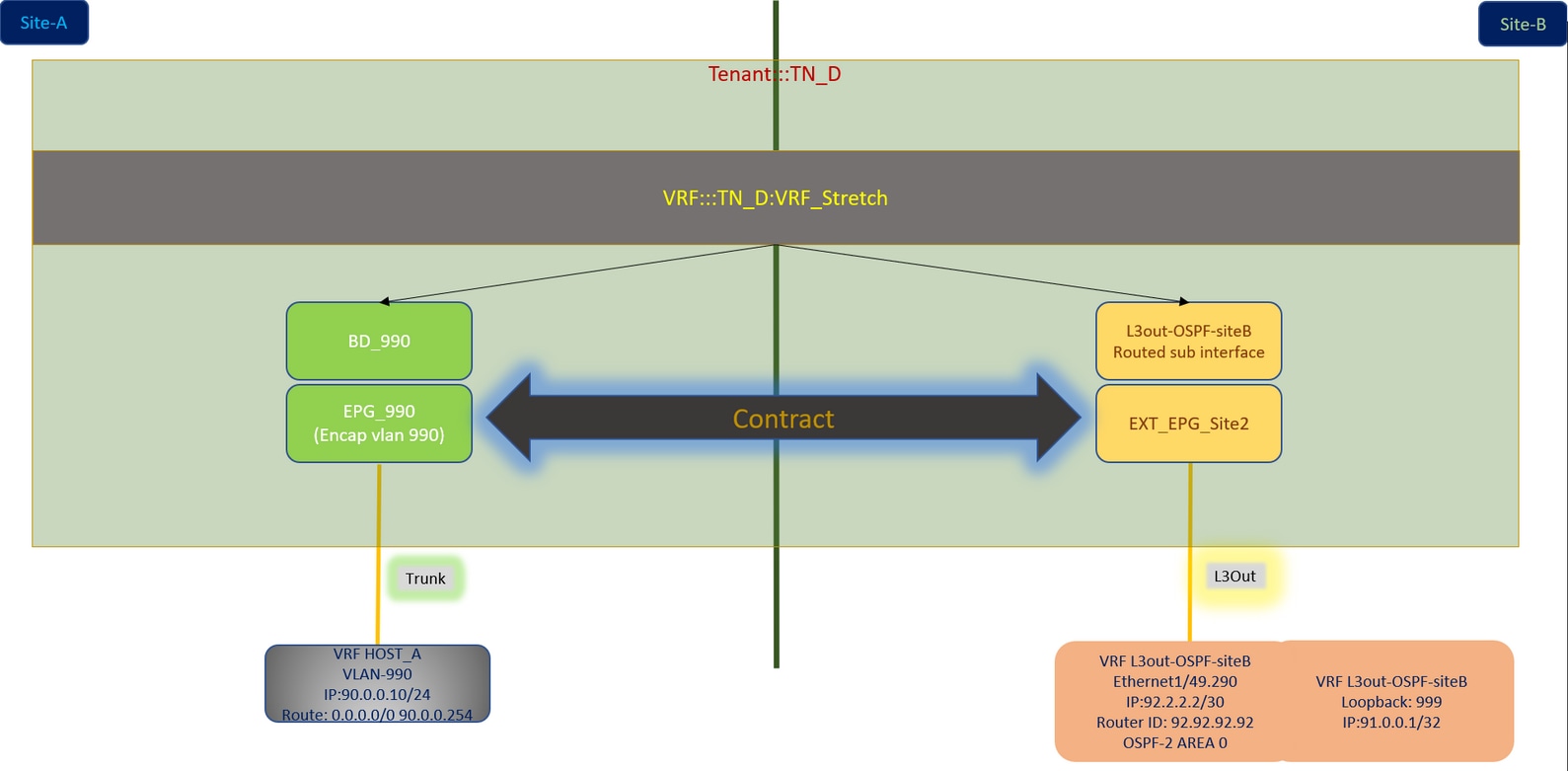
配置
在本示例中,我们使用Schema-config1。但是,此配置可以以类似方式完成(根据合同关系进行微小更改)其他受支持的架构配置,但拉伸对象需要位于拉伸模板而不是特定站点模板中。
配置架构配置1
- 租户在站点(A和B)之间延伸。
- VRF在站点(A和B)之间延伸。
- EPG/BD本地到一个站点(A)。
- L3out本地到另一个站点(B)。
- L3out本地到站点(B)的外部EPG。
- 从MSO创建合同和配置。
查看站点间L3Out准则和限制。
-
站点间L3out的配置不受支持:
-
站点中的组播接收器,通过另一站点L3out从外部源接收组播。站点中从外部源接收的组播从不发送到其他站点。当站点中的接收方从外部源接收组播时,必须在本地L3out上接收组播。
-
内部组播源使用PIM-SM任意源组播(ASM)将组播发送到外部接收器。 内部组播源必须能够从本地L3out到达外部交汇点(RP)。
-
巨型OverLay交换矩阵(GOLF)。
-
外部EPG的首选组。
-
配置交换矩阵策略
每个站点的交换矩阵策略是基本配置,因为这些策略配置链接到特定租户/EPG/静态端口绑定或L3out物理连接。使用交换矩阵策略的任何错误配置都可能导致来自APIC或MSO的逻辑配置失败,从而导致实验室设置中使用的所提供的交换矩阵策略配置失败。它有助于了解在MSO或APIC中链接到哪个对象的对象。
Host_A站点A的连接交换矩阵策略

站点B的L3out连接交换矩阵策略

可选步骤
一旦为各个连接设置了交换矩阵策略,您就可以确保从各个APIC集群发现并可访问所有枝叶/主干。接下来,您可以验证从MSO可到达的两个站点(APIC集群),并且多站点设置可操作(和IPN连接)。
配置RTEP/ETEP
可路由隧道终端池(RTEP)或外部隧道终端池(ETEP)是站点间L3out的必需配置。旧版本的MSO显示“可路由TEP池”,而较新版本的MSO显示“外部TEP池”,但两者同义。这些TEP池通过VRF“Overlay-1”用于边界网关协议(BGP)以太网VPN(EVPN)。
来自L3out的外部路由通过BGP EVPN通告到另一个站点。此RTEP/ETEP也用于远程枝叶配置,因此,如果APIC中已存在ETEP/RTEP配置,则必须将其导入MSO。
以下是从MSO GUI配置ETEP的步骤。由于版本为3.X MSO,因此它显示ETEP。ETEP池在每个站点必须唯一,并且不得与每个站点的任何内部EPG/BD子网重叠。
站点A
步骤1.在MSO GUI页面(在网页中打开多站点控制器)中,选择“基础设施”>“基础设施配置”。单击Configure Infra。

步骤2.在Configure Infra中,选择Site-A,Inside Site-A,选择pod-1。然后,在Pod-1内部,使用Site-A的外部TEP IP地址配置External TEP Pools。(在本例中为192.168.200.0/24)。 如果站点A中有多POD,请对其他Pod重复此步骤。

步骤3.要验证APIC GUI中ETEP池的配置,请选择Fabric > Inventory > Pod Fabric Setup Policy > Pod-ID(双击以打开[Fabric Setup Policy a POD-Pod-x])> External TEP。

您还可以使用以下命令验证配置:
moquery -c fabricExtRoutablePodSubnet
moquery -c fabricExtRoutablePodSubnet -f 'fabric.ExtRoutablePodSubnet.pool=="192.168.200.0/24"'
APIC1# moquery -c fabricExtRoutablePodSubnet Total Objects shown: 1 # fabric.ExtRoutablePodSubnet pool : 192.168.200.0/24 annotation : orchestrator:msc childAction : descr : dn : uni/controller/setuppol/setupp-1/extrtpodsubnet-[192.168.200.0/24] extMngdBy : lcOwn : local modTs : 2021-07-19T14:45:22.387+00:00 name : nameAlias : reserveAddressCount : 0 rn : extrtpodsubnet-[192.168.200.0/24] state : active status : uid : 0
站点B
步骤1.为站点B配置外部TEP池(与站点A的步骤相同) 在MSO GUI页面(在网页中打开多站点控制器)中,选择Infrastructure > Infra Configuration。单击配置基础设施。在配置基础设施内,选择站点B。在Site-B内,选择pod-1。然后,在Pod-1内,使用站点B的外部TEP IP地址配置External TEP Pools。(在本例中为192.168.100.0/24)。 如果您在站点B中有多POD,请对其他Pod重复此步骤。

步骤2.要验证APIC GUI中ETEP池的配置,请选择Fabric > Inventory > Pod Fabric Setup Policy > Pod-ID(双击以打开[Fabric Setup Policy a POD-Pod-x])> External TEP。
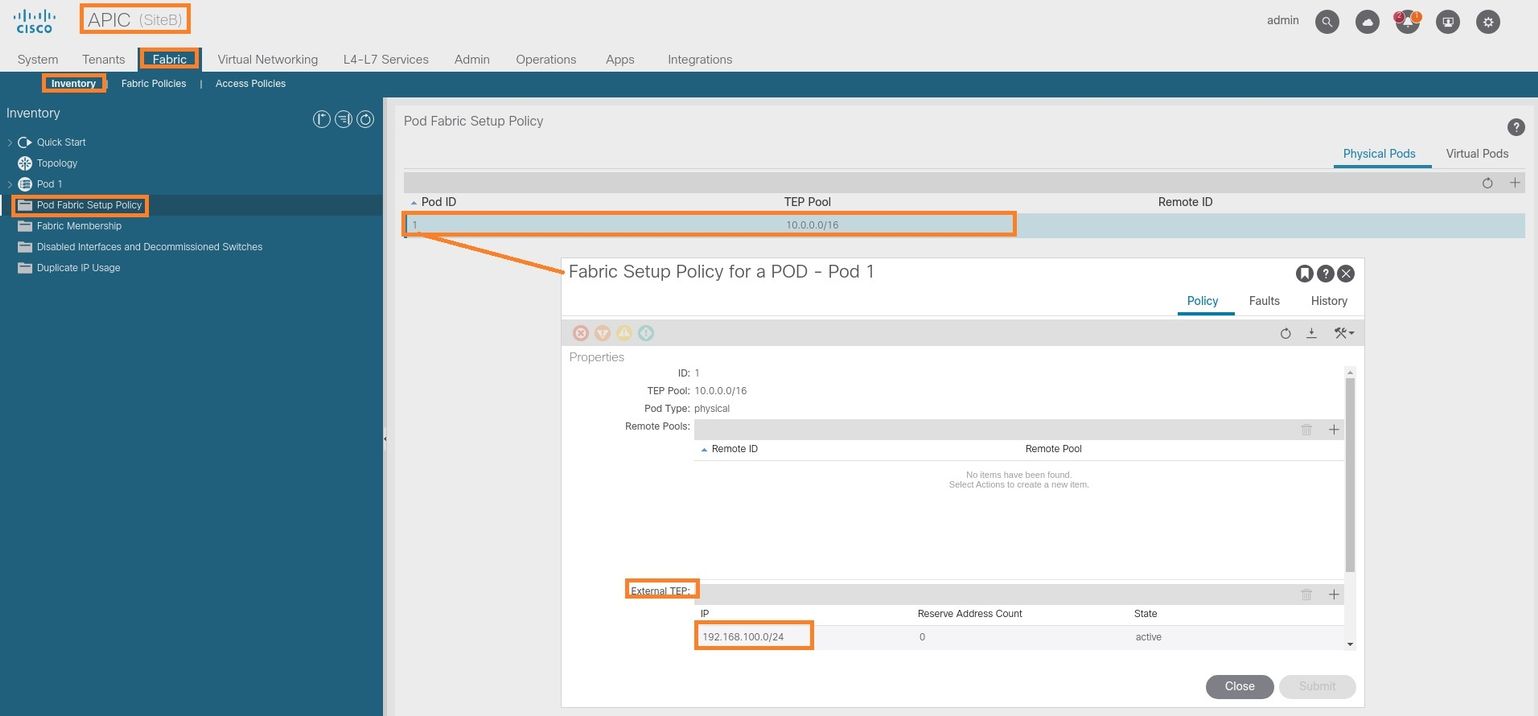
对于Site-B APIC,输入此命令以验证ETEP地址池。
apic1# moquery -c fabricExtRoutablePodSubnet -f 'fabric.ExtRoutablePodSubnet.pool=="192.168.100.0/24"' Total Objects shown: 1 # fabric.ExtRoutablePodSubnet pool : 192.168.100.0/24 annotation : orchestrator:msc <<< This means, configuration pushed from MSO. childAction : descr : dn : uni/controller/setuppol/setupp-1/extrtpodsubnet-[192.168.100.0/24] extMngdBy : lcOwn : local modTs : 2021-07-19T14:34:18.838+00:00 name : nameAlias : reserveAddressCount : 0 rn : extrtpodsubnet-[192.168.100.0/24] state : active status : uid : 0
配置Stretch租户
步骤1.在MSO GUI中,选择Application Management > Tenants。 单击“添加租户”。在本例中,租户名称为“TN_D”。

步骤2.在“显示名称”字段中,输入租户的名称。在“关联的站点”部分,选中“站点A”和“站点B”复选框。
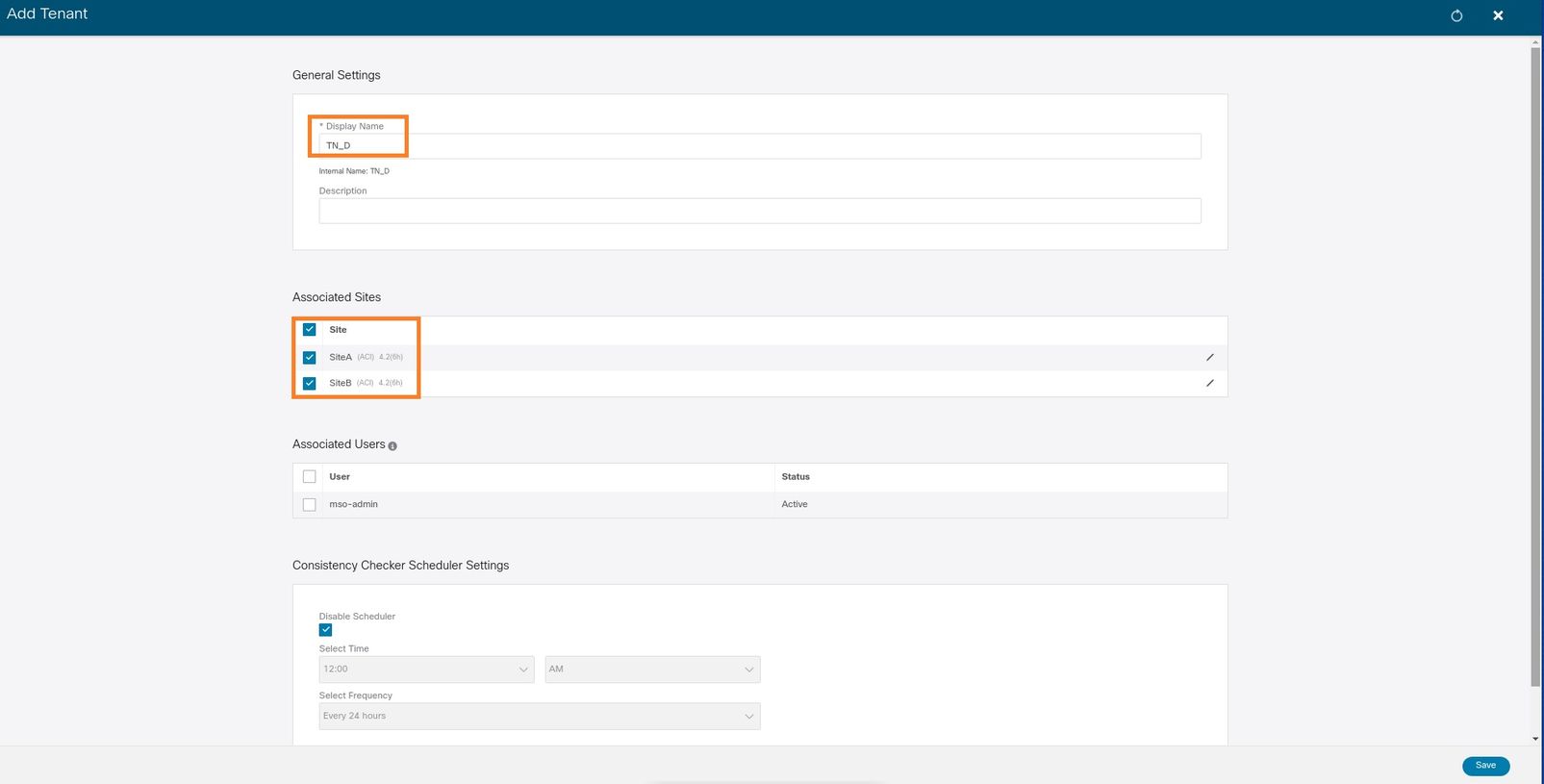
步骤3.检验新租户“Tn_D”是否已创建。

逻辑视图
从MSO创建租户时,它基本上会在站点A和站点B创建租户。它是一个延伸租户。此租户的逻辑视图如本例所示。此逻辑视图有助于了解租户TN_D是站点A和站点B之间的扩展租户。
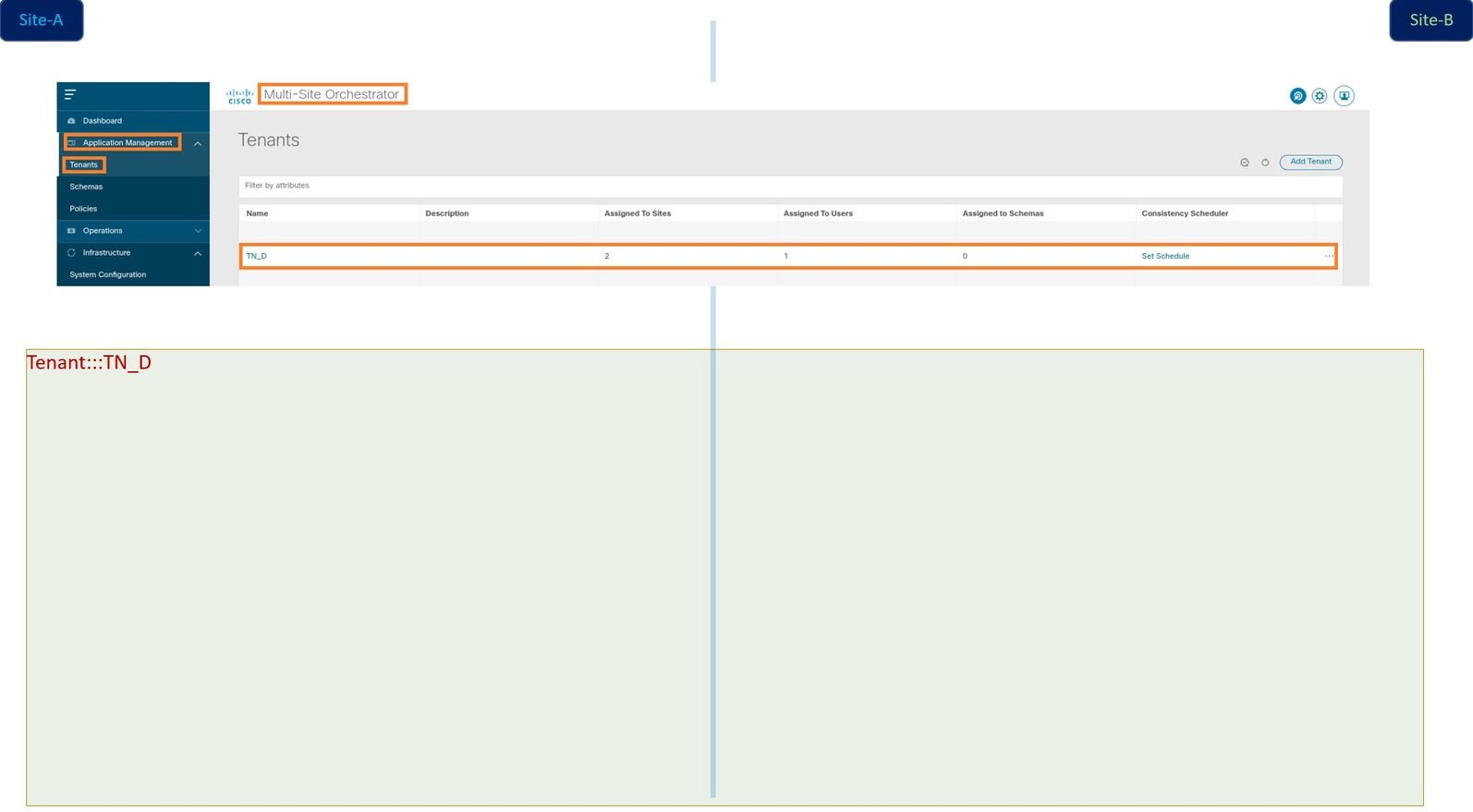
您可以验证每个站点的APIC中的逻辑视图。您可以看到站点A和站点B都显示已创建“TN_D”租户。

站点B中也创建了相同的拉伸租户“TN_D”。

此命令显示从MSO推送的租户,您可以将其用于验证目的。您可以在两个站点的APIC中运行此命令。
APIC1# moquery -c fvTenant -f 'fv.Tenant.name=="TN_D"' Total Objects shown: 1 # fv.Tenant name : TN_D annotation : orchestrator:msc childAction : descr : dn : uni/tn-TN_D extMngdBy : msc lcOwn : local modTs : 2021-09-17T21:42:52.218+00:00 monPolDn : uni/tn-common/monepg-default nameAlias : ownerKey : ownerTag : rn : tn-TN_D status : uid : 0
apic1# moquery -c fvTenant -f 'fv.Tenant.name=="TN_D"' Total Objects shown: 1 # fv.Tenant name : TN_D annotation : orchestrator:msc childAction : descr : dn : uni/tn-TN_D extMngdBy : msc lcOwn : local modTs : 2021-09-17T21:43:04.195+00:00 monPolDn : uni/tn-common/monepg-default nameAlias : ownerKey : ownerTag : rn : tn-TN_D status : uid : 0
配置方案
接下来,创建一个共有三个模板的架构:
- 站点A的模板:站点A的模板仅与站点A关联,因此该模板中的任何逻辑对象配置都只能推送到站点A的APIC。
- 站点B的模板:站点B的模板仅与站点B关联,因此该模板中的任何逻辑对象配置都只能推送到站点B的APIC。
- 拉伸模板:拉伸模板与两个站点关联,并且拉伸模板中的任何逻辑配置都可推送到APIC的两个站点。
创建架构
方案在MSO中具有本地意义,它不在APIC中创建任何对象。方案配置是每个配置的逻辑分离。您可以为同一租户使用多个架构,也可以在每个架构内使用多个模板。
例如,您可以为租户X的数据库服务器设置一个模式,而应用服务器为同一租户X使用不同的模式。这有助于分离每个与应用程序相关的特定配置,并且在您需要调试问题时非常容易。信息也很容易找到。
使用租户名称(例如TN_D_Schema)创建架构。 但是,不需要将架构名称以租户名称开头,您可以创建具有任何名称的架构。
步骤1.选择应用程序管理>方案。单击“添加架构”。

步骤2.在“名称”字段中,输入方案的名称。在本例中,它是“TN_D_Schema”,但是,您可以保留适合您环境的任何名称。单击 Add。

步骤3.检验架构“TN_D_Schema”是否已创建。

创建站点A模板
步骤1.在架构内添加模板。
- 要创建模板,请单击已创建的架构下的模板。此时将显示“选择模板类型”对话框。
- 选择ACI Multi-cloud。
- 单击 Add。

步骤2.输入模板的名称。此模板特定于站点A,因此模板名称为“站点A模板”。 创建模板后,可以将特定租户附加到模板。在本例中,租户“TN_D”已附加。

配置模板
应用配置文件配置
步骤1.从您创建的方案中,选择Site-A模板。单击“添加应用配置文件”。

步骤2.在“显示名称”字段中,输入应用配置文件名App_Profile。
步骤3.下一步是创建EPG。要在应用配置文件下添加EPG,请点击Site-A模板下的Add EPG。您可以看到在EPG配置内创建了新EPG。

步骤4.为了将EPG与BD和VRF连接,您必须在EPG下添加BD和VRF。选择Site-A模板。在显示名称字段中,输入EPG的名称并附加新BD(您可以创建新BD或附加现有BD)。

请注意,您必须将VRF连接到BD,但VRF在本例中是拉伸的。您可以使用拉伸VRF创建拉伸模板,然后将该VRF附加到站点特定模板下的BD(在我们的例子中为站点A模板)。
创建拉伸模板
步骤1.要创建拉伸模板,请在TN_D_Schema下单击Templates。此时将显示“选择模板类型”对话框。选择ACI Multi-cloud。单击 Add。输入模板的名称“延伸模板”。(可以为拉伸模板输入任何名称。)

步骤2.选择“拉伸模板”并创建名为VRF_Stretch的VRF。(可以输入VRF的任何名称。)

BD是通过在Site-A模板下创建EPG而创建的,但没有附加VRF,因此您必须附加VRF,该VRF现在在延伸模板中创建。
步骤3.选择Site-A Template > BD_990。在“虚拟路由和转发”下拉列表中,选择VRF_Stretch。(您在本节步骤2中创建的。)

附加模板
下一步是仅将Site-A模板附加Site-A,并且拉伸模板需要附加到两个站点。单击Deploy to site inside the schema,以将模板部署到各个站点。
步骤1.单击TN_D_Schema > SITES下的+号将站点添加到模板。在分配到模板下拉列表中,选择相应站点的相应模板。

步骤2.您可以看到站点A现在已创建EPG和BD,但站点B没有创建相同的EPG/BD,因为这些配置仅适用于来自MSO的站点A。但是,您可以看到VRF是在拉伸模板中创建的,因此在两个站点中创建。

步骤3.使用这些命令检验配置。
APIC1# moquery -c fvAEPg -f 'fv.AEPg.name=="EPG_990"' Total Objects shown: 1 # fv.AEPg name : EPG_990 annotation : orchestrator:msc childAction : configIssues : configSt : applied descr : dn : uni/tn-TN_D/ap-App_Profile/epg-EPG_990 exceptionTag : extMngdBy : floodOnEncap : disabled fwdCtrl : hasMcastSource : no isAttrBasedEPg : no isSharedSrvMsiteEPg : no lcOwn : local matchT : AtleastOne modTs : 2021-09-18T08:26:49.906+00:00 monPolDn : uni/tn-common/monepg-default nameAlias : pcEnfPref : unenforced pcTag : 32770 prefGrMemb : exclude prio : unspecified rn : epg-EPG_990 scope : 2850817 shutdown : no status : triggerSt : triggerable txId : 1152921504609182523 uid : 0
APIC1# moquery -c fvBD -f 'fv.BD.name=="BD_990"'
Total Objects shown: 1
# fv.BD
name : BD_990
OptimizeWanBandwidth : yes
annotation : orchestrator:msc
arpFlood : yes
bcastP : 225.0.56.224
childAction :
configIssues :
descr :
dn : uni/tn-TN_D/BD-BD_990
epClear : no
epMoveDetectMode :
extMngdBy :
hostBasedRouting : no
intersiteBumTrafficAllow : yes
intersiteL2Stretch : yes
ipLearning : yes
ipv6McastAllow : no
lcOwn : local
limitIpLearnToSubnets : yes
llAddr : ::
mac : 00:22:BD:F8:19:FF
mcastAllow : no
modTs : 2021-09-18T08:26:49.906+00:00
monPolDn : uni/tn-common/monepg-default
mtu : inherit
multiDstPktAct : bd-flood
nameAlias :
ownerKey :
ownerTag :
pcTag : 16387
rn : BD-BD_990
scope : 2850817
seg : 16580488
status :
type : regular
uid : 0
unicastRoute : yes
unkMacUcastAct : proxy
unkMcastAct : flood
v6unkMcastAct : flood
vmac : not-applicable
: 0
APIC1# moquery -c fvCtx -f 'fv.Ctx.name=="VRF_Stretch"' Total Objects shown: 1 # fv.Ctx name : VRF_Stretch annotation : orchestrator:msc bdEnforcedEnable : no childAction : descr : dn : uni/tn-TN_D/ctx-VRF_Stretch extMngdBy : ipDataPlaneLearning : enabled knwMcastAct : permit lcOwn : local modTs : 2021-09-18T08:26:58.185+00:00 monPolDn : uni/tn-common/monepg-default nameAlias : ownerKey : ownerTag : pcEnfDir : ingress pcEnfDirUpdated : yes pcEnfPref : enforced pcTag : 16386 rn : ctx-VRF_Stretch scope : 2850817 seg : 2850817 status : uid : 0
配置静态端口绑定
现在,您可以在EPG“EPG_990”下配置静态端口绑定,也可以使用VRF HOST_A配置N9K(基本上是模拟HOST_A)。 ACI端静态端口绑定配置将首先完成。
步骤1.在EPG_990下添加物理域。
- 从您创建的架构中,选择Site-A Template > EPG_990。
- 在“模板属性”框中,单击添加域。
- 在“添加域”对话框中,从下拉列表中选择以下选项:
- 域关联类型 — 物理
- 域配置文件- TN_D_PhysDom
- 部署即时性 — 即时
- 解决方案即时性 — 即时
- Click Save.

步骤2.添加静态端口(Site1_Leaf1 eth1/5)。
- 从您创建的架构中,选择Site-A Template > EPG_990。
- 在“模板属性”框中,单击添加静态端口。
- 在“在PC、VPC或接口上添加静态EPG”对话框中,选择Node-101 eth1/5并分配VLAN 990。

步骤3.确保在EPG_990下添加静态端口和物理域。
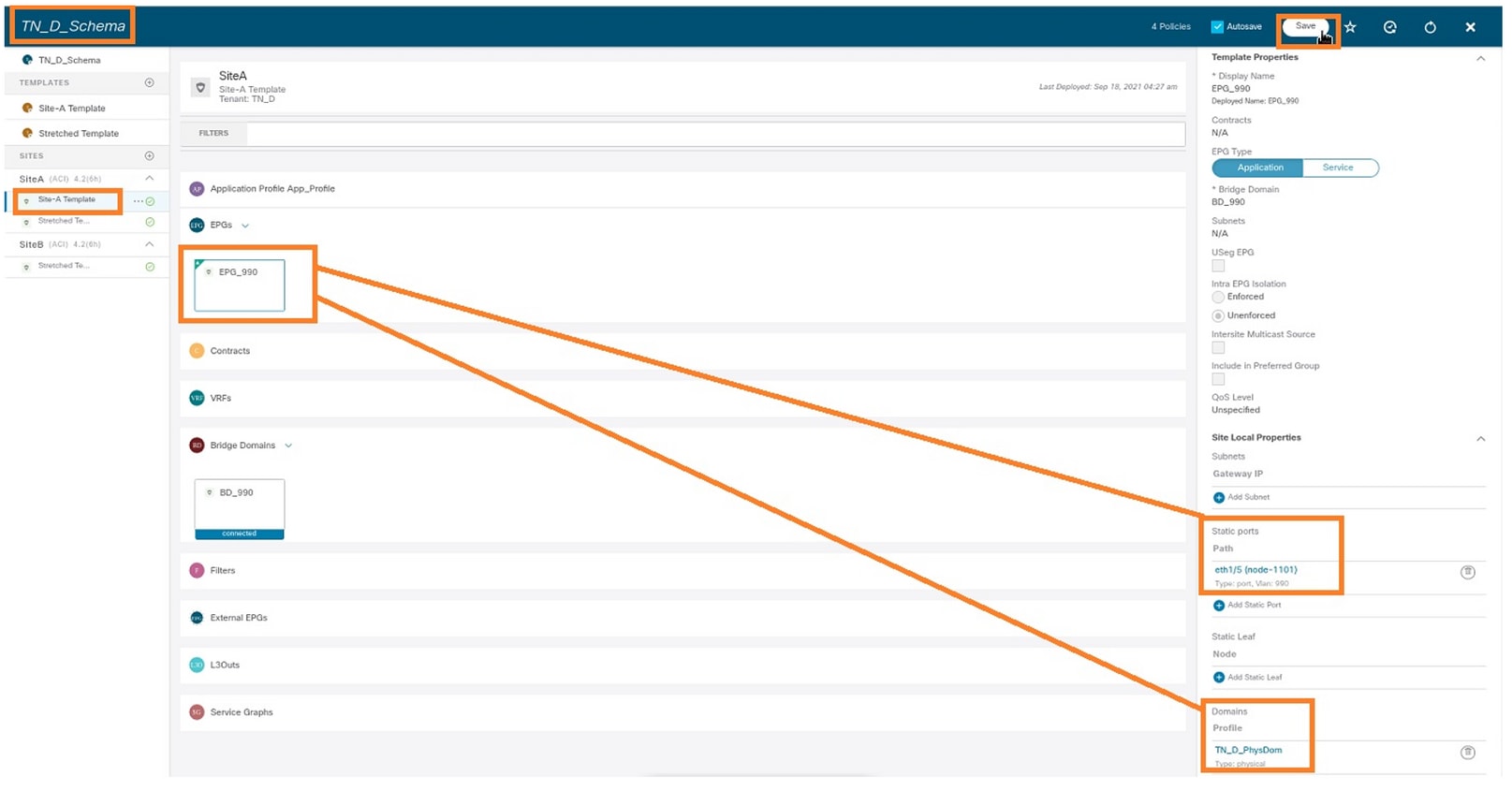
使用以下命令验证静态路径绑定:
APIC1# moquery -c fvStPathAtt -f 'fv.StPathAtt.pathName=="eth1/5"' | grep EPG_990 -A 10 -B 5 # fv.StPathAtt pathName : eth1/5 childAction : descr : dn : uni/epp/fv-[uni/tn-TN_D/ap-App_Profile/epg-EPG_990]/node-1101/stpathatt-[eth1/5] lcOwn : local modTs : 2021-09-19T06:16:46.226+00:00 monPolDn : uni/tn-common/monepg-default name : nameAlias : ownerKey : ownerTag : rn : stpathatt-[eth1/5] status :
配置BD
步骤1.在BD下添加子网/IP(HOST_A使用BD IP作为网关)。
- 从您创建的架构中,选择Site-A Template > BD_990。
- 单击Add Subnet。
- 在添加新子网对话框中,输入网关IP地址,然后单击外部通告单选按钮。
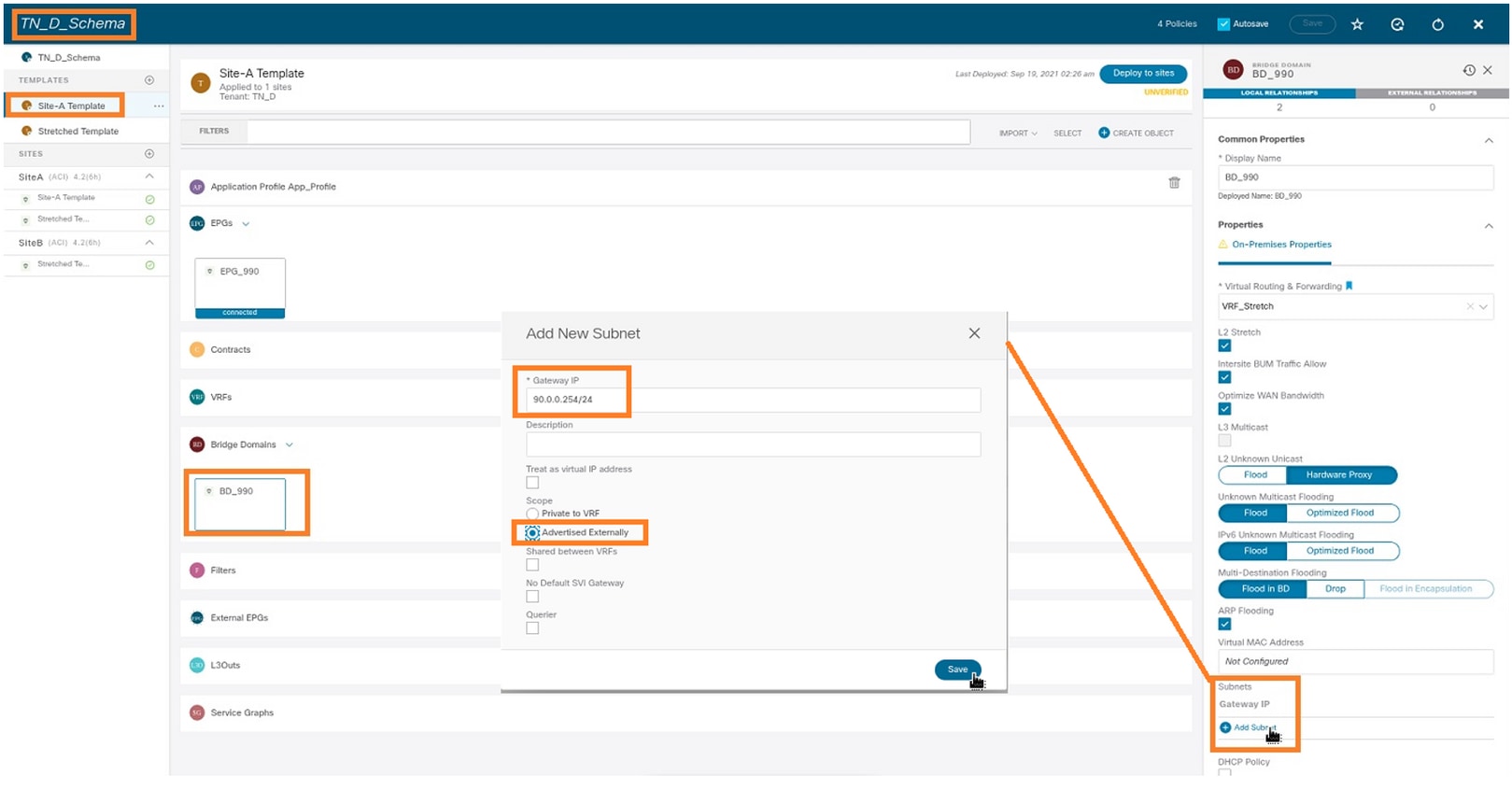
步骤2.使用此命令检验子网是否已添加到APIC1 Site-A中。
APIC1# moquery -c fvSubnet -f 'fv.Subnet.ip=="90.0.0.254/24"' Total Objects shown: 1 # fv.Subnet ip : 90.0.0.254/24 annotation : orchestrator:msc childAction : ctrl : nd descr : dn : uni/tn-TN_D/BD-BD_990/subnet-[90.0.0.254/24] extMngdBy : lcOwn : local modTs : 2021-09-19T06:33:19.943+00:00 monPolDn : uni/tn-common/monepg-default name : nameAlias : preferred : no rn : subnet-[90.0.0.254/24] scope : public status : uid : 0 virtual : no
步骤3.部署Site-A模板。
- 从您创建的架构中,选择Site-A Template。
- 单击“部署到站点”。
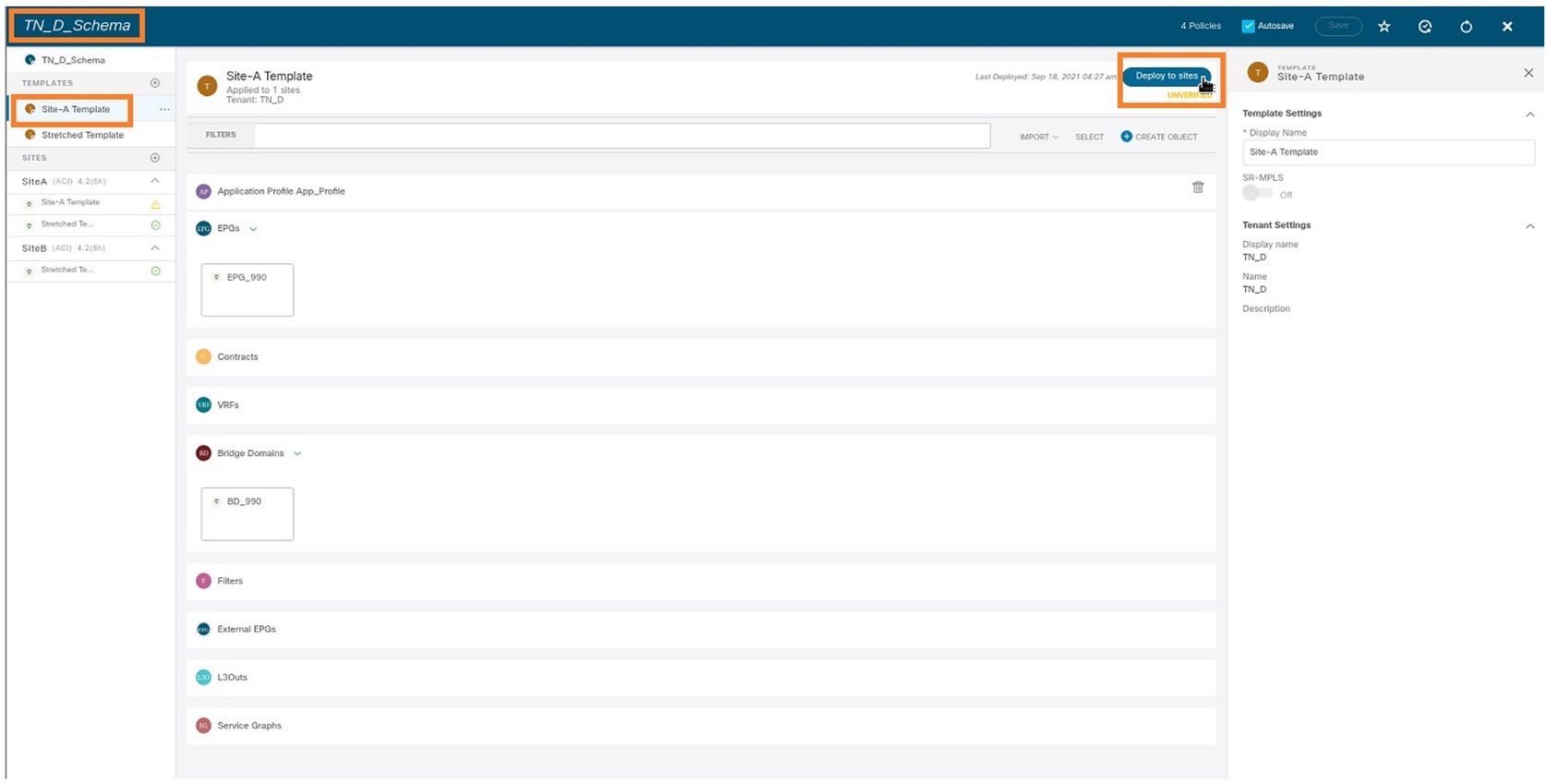
配置主机A(N9K)
使用VRF HOST_A配置N9K设备。完成N9K配置后,您可以看到ACI枝叶BD任播地址(HOST_A的网关)现在可通过ICMP(ping)到达。

在ACI操作选项卡中,您可以看到90.0.0.10(HOST_A IP地址)已获知。

创建站点B模板
步骤1.从您创建的方案中,选择TEMPLATES。单击+号,然后创建名为Site-B Template的模板。

配置站点B L3out
创建L3out并连接VRF_Stretch。您必须从MSO创建L3out对象,其余L3out配置需要从APIC完成(因为L3out参数在MSO中不可用)。 此外,从MSO创建外部EPG(仅在站点B模板中,因为外部EPG不延伸)。
步骤1.从您创建的方案中,选择Site-B Template。在“显示名称”字段中,输入L3out_OSPF_siteB。在虚拟路由和转发下拉列表中,选择VRF_Stretch。

创建外部EPG
步骤1.从您创建的方案中,选择Site-B Template。单击Add External EPG。

步骤2.将L3out与外部EPG连接。
- 从您创建的架构中,选择Site-B Template。
- 在“显示名称”字段中,输入EXT_EPG_Site2。
- 在分类子网字段中,输入0.0.0.0/0作为外部EPG的外部子网。

其余L3out配置从APIC(站点B)完成。
步骤3.添加L3域,启用OSPF协议,并使用常规区域0配置OSPF。
- 从Site-B的APIC-1,选择TN_D > Networking > L3out-OSPF-siteB > Policy > Main。
- 在L3域下拉列表中,选择TN_D_L3Dom。
- 选中启用BGP/EIGRP/OSPF的OSPF复选框。
- 在OSPF区域ID字段中,输入0。
- 在OSPF区域类型中,选择常规区域。
- 单击“Submit”。

步骤4.创建节点配置文件。
- 从Site-B的APIC-1,选择TN_D > Networking > L3Outs > L3Out-OSPF-siteB > Logical Node Profiles。
- 单击“创建节点配置文件”。

步骤5.选择交换机Site2_Leaf1作为站点B的节点。
- 从Site-B的APIC-1,选择TN_D > Networking > L3Outs > L3Out-OSPF-siteB > Logical Node Profiles > Create Node Profile。
- 在“名称”字段中,输入Site2_Leaf1。
- 单击+号添加节点。
- 使用路由器ID IP地址添加Pod-2节点101。

步骤6.添加接口配置文件(外部VLAN为920(SVI创建))。
- 从Site-B的APIC-1,选择TN_D > Networking > L3Outs > L3out-OSPF-SiteB > Logical Interface Profiles。
- 右键单击并添加接口配置文件。
- 选择Routed Sub-Interfaces。
- 配置IP地址、MTU和VLAN-920。
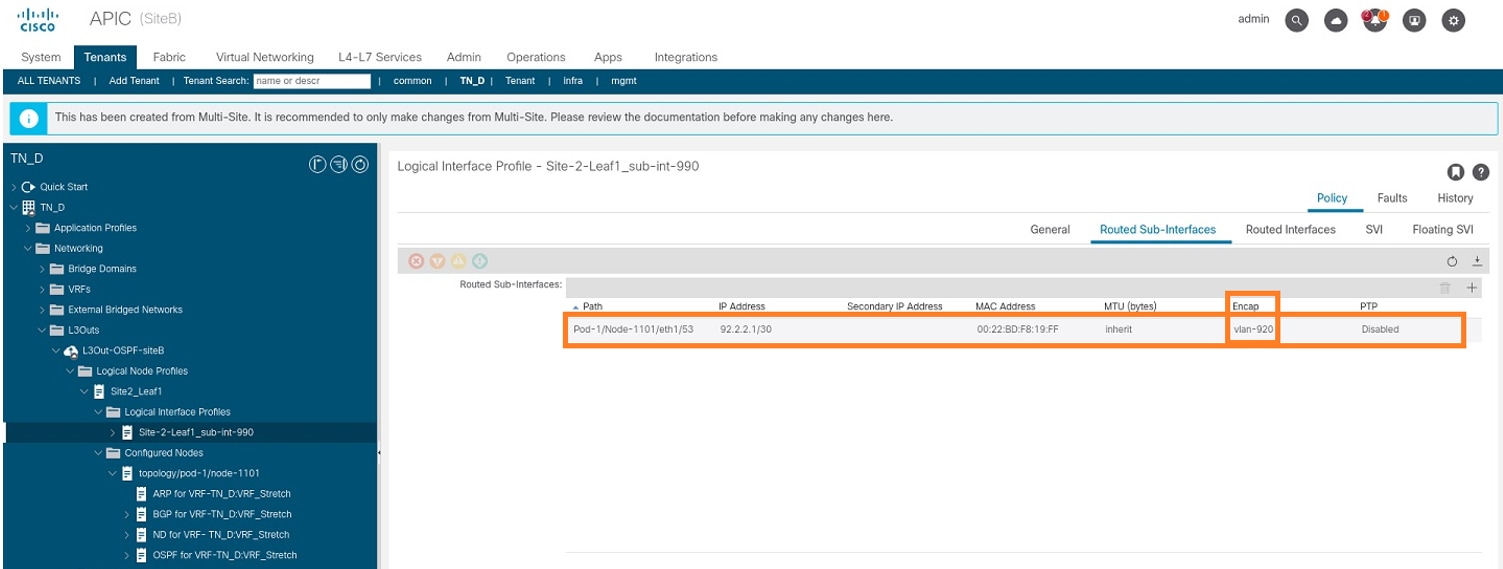
步骤7.创建OSPF策略(点对点网络)。
- 从Site-B的APIC-1中,选择TN_D > Networking > L3Outs > L3Out-OSPF-siteB > Logical Interface Profiles。
- 右键单击并选择Create OSPF Interface Profile。
- 选择屏幕截图中显示的选项,然后单击“提交”。
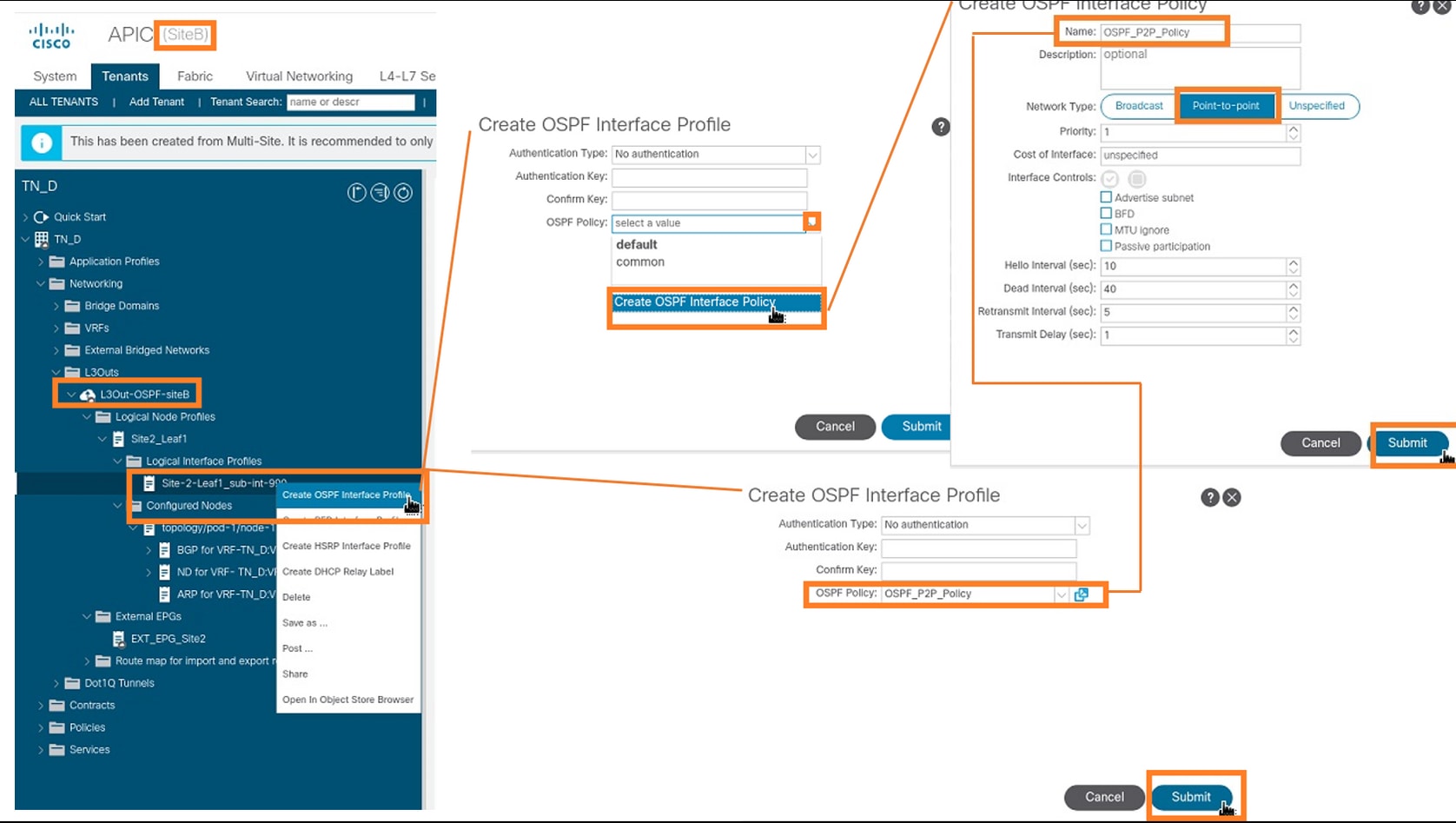
步骤8.检验在TN_D > Networking > L3Outs > L3Out-OSPF-siteB > Logical Interface Profiles >(接口配置文件)> OSPF Interface Profile下附加的OSPF接口配置文件策略。

步骤9.验证外部EPG“EXT_EPG_Site2”是否由MSO创建。从Site-B的APIC-1,选择TN_D > L3Outs > L3Out-OSPF-siteB > External EPGs > EXT_EPG_Site2。

配置外部N9K(站点B)
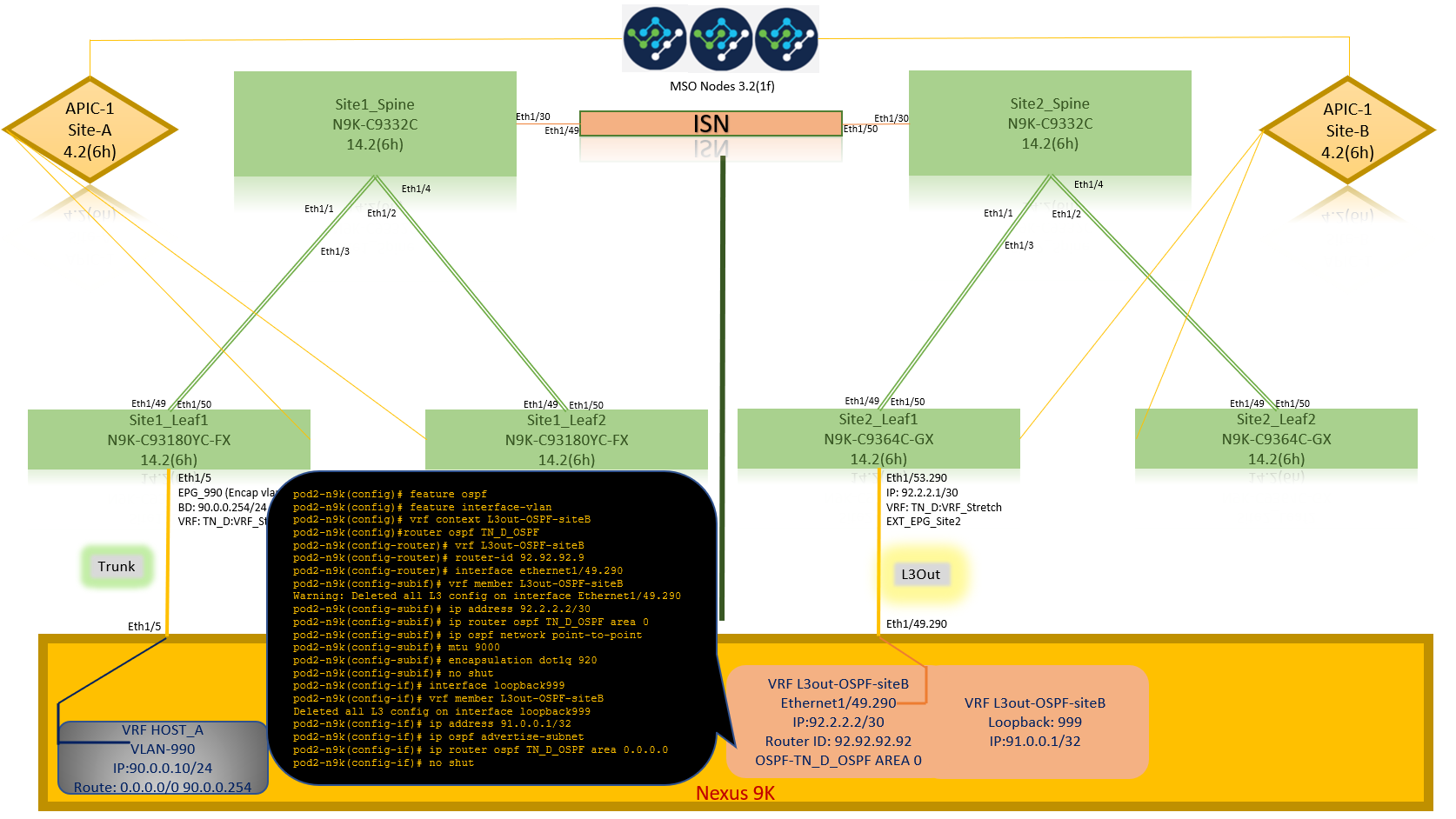
在N9K配置(VRF L3out-OSPF-siteB)后,我们可以看到N9K与ACI枝叶(位于站点B)之间已建立OSPF邻居关系。
验证OSPF邻居关系已建立且UP(完全状态)。
从站点B的APIC-1,选择TN_D > Networking > L3Outs > L3Out-OSPF-siteB > Logical Node Profiles > Logical Interface Profiles > Configured Nodes > topology/pod01/node-1101 > OSPF for VRF_DVRF_Switch > Neighbor ID state > Full。
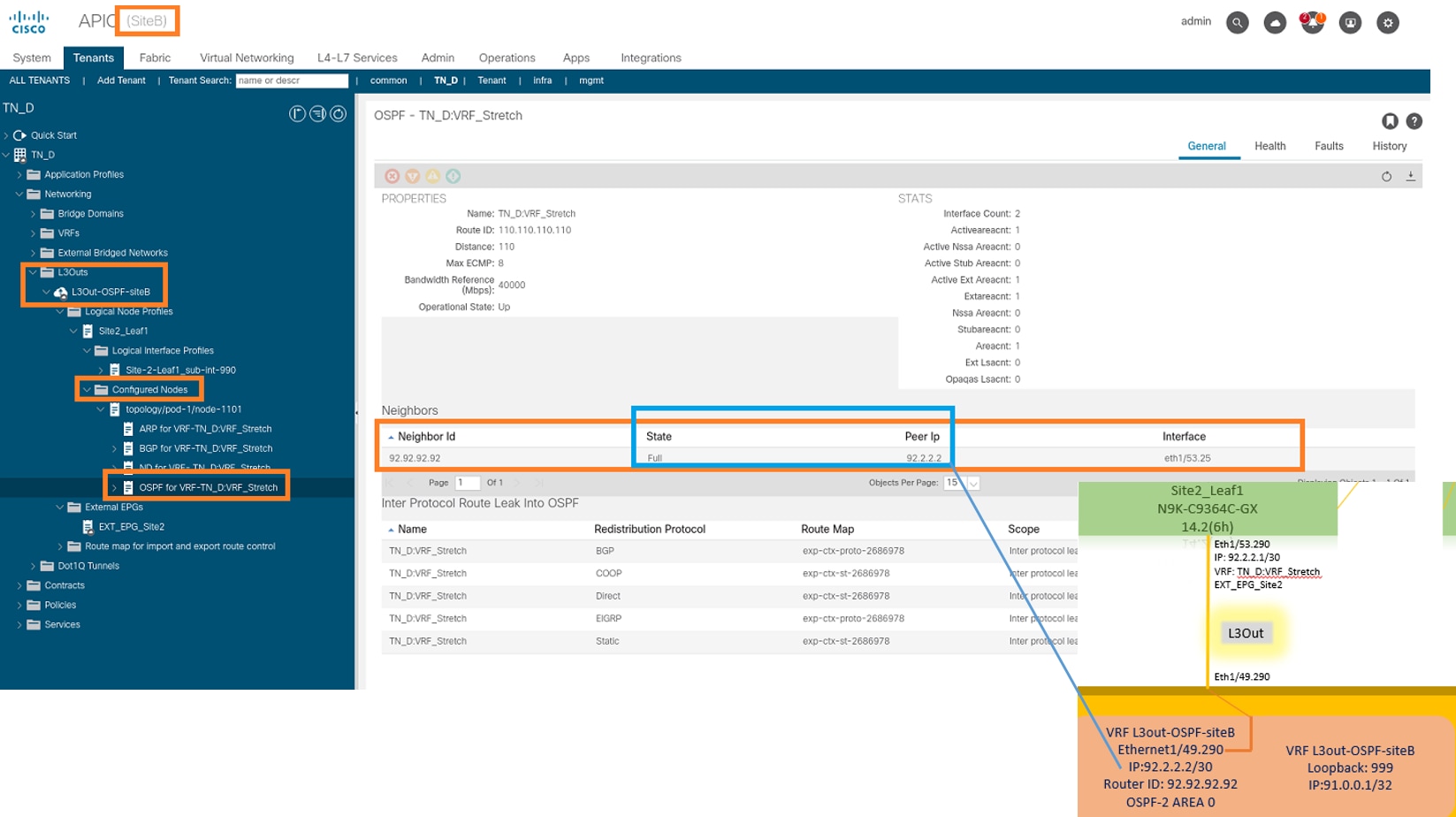
您还可以在N9K中检查OSPF邻居关系。此外,您还能ping通ACI枝叶IP(站点B)。

此时,站点A的Host_A配置和站点B的L3out配置已完成。

将站点B L3out连接到站点A EPG(BD)
接下来,您可以从MSO将Site-B L3out连接到Site-A BD-990。请注意,左侧列有两个部分:1)模板和2)站点。
步骤1.在“站点”的第二部分,您可以看到每个站点附加的模板。将L3out附加到“Site-A Template”时,您基本上是从“Sites”部分内已附加的模板附加。
但是,在部署模板时,请从“模板”>“站点 — A模板”部分进行部署,然后选择保存/部署到站点。


步骤2.从主模板“Site-A Template”(站点A模板)的第一部分“Templates”(模板)部署。

配置合同
您需要在站点B的外部EPG和站点A的内部EPG_990之间签订合同。因此,您可以先从MSO创建合同,然后将其附加到两个EPG。
思科以应用为中心的基础设施 — 思科ACI合同指南可帮助理解合同。通常,内部EPG配置为提供商,而外部EPG配置为消费者。

创建合同
步骤1.从TN_D_Schema中,选择“拉伸模板”>“合同”。单击 添加合同。

步骤2.添加过滤器以允许所有流量。
- 从TN_D_Schema中,选择“延伸模板”>“合同”。
- 添加合同时应:
- 显示姓名:站点间L3输出合同
- 范围: VRF

第三步:
- 从TN_D_Schema中,选择“延伸模板”>“过滤器”。
- 在“显示名称”字段中,输入“允许所有流量”。
- 单击Add Entry。系统随即会显示“添加条目”对话框。
- 在“名称”字段中,输入Any_Traffic。
- 在Ether Type下拉列表中,选择未指定以允许所有流量。
- Click Save.

步骤4.将合同作为“消费者”(在站点B模板中)添加到外部EPG(部署到站点)。
- 从TN_D_Schema中,选择Site-B Template > EXT_EPG_Site2。
- 单击“添加合同”。系统随即会显示“添加合同”对话框。
- 在“合同”字段中,输入Intersite-L3out-Contract。
- 在“类型”下拉列表中,选择消费者。

步骤5.将合同作为“提供商”(在Site-A模板中)添加到内部EPG“EPG_990”(部署到站点)。
- 从TN_D_Schema中,选择Site-A Template > EPG_990。
- 单击“添加合同”。系统随即会显示“添加合同”对话框。
- 在“Contract”(合同)字段中,输入Intersite-L3out-Contract。
- 在“类型”下拉列表中,选择“提供程序”。

一旦添加合同,您就会看到在站点A创建的“影子L3out /外部EPG”。

您还可以看到,“Shadow EPG_990和BD_990”也是在站点B上创建的。

步骤6.输入这些命令以检验Site-B APIC。
apic1# moquery -c fvAEPg -f 'fv.AEPg.name=="EPG_990"' Total Objects shown: 1 # fv.AEPg name : EPG_990 annotation : orchestrator:msc childAction : configIssues : configSt : applied descr : dn : uni/tn-TN_D/ap-App_Profile/epg-EPG_990 exceptionTag : extMngdBy : floodOnEncap : disabled fwdCtrl : hasMcastSource : no isAttrBasedEPg : no isSharedSrvMsiteEPg : no lcOwn : local matchT : AtleastOne modTs : 2021-09-19T18:47:53.374+00:00 monPolDn : uni/tn-common/monepg-default nameAlias : pcEnfPref : unenforced pcTag : 49153 <<< Note that pcTag is different for shadow EPG. prefGrMemb : exclude prio : unspecified rn : epg-EPG_990 scope : 2686978 shutdown : no status : triggerSt : triggerable txId : 1152921504609244629 uid : 0
apic1# moquery -c fvBD -f 'fv.BD.name==\"BD_990\"' Total Objects shown: 1 # fv.BD name : BD_990 OptimizeWanBandwidth : yes annotation : orchestrator:msc arpFlood : yes bcastP : 225.0.181.192 childAction : configIssues : descr : dn : uni/tn-TN_D/BD-BD_990 epClear : no epMoveDetectMode : extMngdBy : hostBasedRouting : no intersiteBumTrafficAllow : yes intersiteL2Stretch : yes ipLearning : yes ipv6McastAllow : no lcOwn : local limitIpLearnToSubnets : yes llAddr : :: mac : 00:22:BD:F8:19:FF mcastAllow : no modTs : 2021-09-19T18:47:53.374+00:00 monPolDn : uni/tn-common/monepg-default mtu : inherit multiDstPktAct : bd-flood nameAlias : ownerKey : ownerTag : pcTag : 32771 rn : BD-BD_990 scope : 2686978 seg : 15957972 status : type : regular uid : 0 unicastRoute : yes unkMacUcastAct : proxy unkMcastAct : flood v6unkMcastAct : flood vmac : not-applicable
步骤7.检查并检验外部设备N9K配置。

验证
使用本部分可确认配置能否正常运行。
终端学习
验证Site-A终端已作为终端在Site1_Leaf1中获知。
Site1_Leaf1# show endpoint interface ethernet 1/5
Legend:
s - arp H - vtep V - vpc-attached p - peer-aged
R - peer-attached-rl B - bounce S - static M - span
D - bounce-to-proxy O - peer-attached a - local-aged m - svc-mgr
L - local E - shared-service
+-----------------------------------+---------------+-----------------+--------------+-------------+
VLAN/ Encap MAC Address MAC Info/ Interface
Domain VLAN IP Address IP Info
+-----------------------------------+---------------+-----------------+--------------+-------------+
18 vlan-990 c014.fe5e.1407 L eth1/5
TN_D:VRF_Stretch vlan-990 90.0.0.10 L eth1/5
ETEP/RTEP验证
站点_A枝叶。
Site1_Leaf1# show ip interface brief vrf overlay-1
IP Interface Status for VRF "overlay-1"(4)
Interface Address Interface Status
eth1/49 unassigned protocol-up/link-up/admin-up
eth1/49.7 unnumbered protocol-up/link-up/admin-up
(lo0)
eth1/50 unassigned protocol-up/link-up/admin-up
eth1/50.8 unnumbered protocol-up/link-up/admin-up
(lo0)
eth1/51 unassigned protocol-down/link-down/admin-up
eth1/52 unassigned protocol-down/link-down/admin-up
eth1/53 unassigned protocol-down/link-down/admin-up
eth1/54 unassigned protocol-down/link-down/admin-up
vlan9 10.0.0.30/27 protocol-up/link-up/admin-up
lo0 10.0.80.64/32 protocol-up/link-up/admin-up
lo1 10.0.8.67/32 protocol-up/link-up/admin-up
lo8 192.168.200.225/32 protocol-up/link-up/admin-up <<<<< IP from ETEP site-A
lo1023 10.0.0.32/32 protocol-up/link-up/admin-up
Site2_Leaf1# show ip interface brief vrf overlay-1
IP Interface Status for VRF "overlay-1"(4)
Interface Address Interface Status
eth1/49 unassigned protocol-up/link-up/admin-up
eth1/49.16 unnumbered protocol-up/link-up/admin-up
(lo0)
eth1/50 unassigned protocol-up/link-up/admin-up
eth1/50.17 unnumbered protocol-up/link-up/admin-up
(lo0)
eth1/51 unassigned protocol-down/link-down/admin-up
eth1/52 unassigned protocol-down/link-down/admin-up
eth1/54 unassigned protocol-down/link-down/admin-up
eth1/55 unassigned protocol-down/link-down/admin-up
eth1/56 unassigned protocol-down/link-down/admin-up
eth1/57 unassigned protocol-down/link-down/admin-up
eth1/58 unassigned protocol-down/link-down/admin-up
eth1/59 unassigned protocol-down/link-down/admin-up
eth1/60 unassigned protocol-down/link-down/admin-up
eth1/61 unassigned protocol-down/link-down/admin-up
eth1/62 unassigned protocol-down/link-down/admin-up
eth1/63 unassigned protocol-down/link-down/admin-up
eth1/64 unassigned protocol-down/link-down/admin-up
vlan18 10.0.0.30/27 protocol-up/link-up/admin-up
lo0 10.0.72.64/32 protocol-up/link-up/admin-up
lo1 10.0.80.67/32 protocol-up/link-up/admin-up
lo6 192.168.100.225/32 protocol-up/link-up/admin-up <<<<< IP from ETEP site-B
lo1023 10.0.0.32/32 protocol-up/link-up/admin-up
ICMP可达性
从HOST_A对外部设备的WAN IP地址执行ping操作。

Ping外部设备环回地址。

路由验证
检验外部设备的WAN IP地址或环回子网路由是否存在于路由表中。当您在“Site1_Leaf1”中检查外部设备子网的下一跳时,它是枝叶“Site2-Leaf1”的外部TEP IP。

Site1_Leaf1# show ip route 92.2.2.2 vrf TN_D:VRF_Stretch
IP Route Table for VRF "TN_D:VRF_Stretch"
'*' denotes best ucast next-hop
'**' denotes best mcast next-hop
'[x/y]' denotes [preference/metric]
'%' in via output denotes VRF
92.2.2.0/30, ubest/mbest: 1/0
*via 192.168.100.225%overlay-1, [200/0], 5d23h, bgp-65001, internal, tag 65001 <<<< Note that next hope is External TEP pool (ETEP) ip address of Site-B.
recursive next hop: 192.168.100.225/32%overlay-1
Site1_Leaf1# show ip route 91.0.0.1 vrf TN_D:VRF_Stretch
IP Route Table for VRF "TN_D:VRF_Stretch"
'*' denotes best ucast next-hop
'**' denotes best mcast next-hop
'[x/y]' denotes [preference/metric]
'%' in via output denotes VRF
91.0.0.1/32, ubest/mbest: 1/0
*via 192.168.100.225%overlay-1, [200/2], 5d23h, bgp-65001, internal, tag 65001 <<<< Note that next hope is External TEP pool (ETEP) ip address of Site-B.
recursive next hop: 192.168.100.225/32%overlay-1
故障排除
本部分提供的信息可用于对配置进行故障排除。
站点2_枝叶1
BGP地址系列路由在TN_D:VRF_stretch和Overlay-1之间导入/导出。
Site2_Leaf1# show system internal epm vrf TN_D:VRF_Stretch
+--------------------------------+--------+----------+----------+------+--------
VRF Type VRF vnid Context ID Status Endpoint
Count
+--------------------------------+--------+----------+----------+------+--------
TN_D:VRF_Stretch Tenant 2686978 46 Up 1
Site2_Leaf1# show vrf TN_D:VRF_Stretch detail
VRF-Name: TN_D:VRF_Stretch, VRF-ID: 46, State: Up
VPNID: unknown
RD: 1101:2686978
Max Routes: 0 Mid-Threshold: 0
Table-ID: 0x8000002e, AF: IPv6, Fwd-ID: 0x8000002e, State: Up
Table-ID: 0x0000002e, AF: IPv4, Fwd-ID: 0x0000002e, State: Up


Site2_Leaf1# vsh
Site2_Leaf1# show bgp vpnv4 unicast 91.0.0.1 vrf TN_D:VRF_Stretch BGP routing table information for VRF overlay-1, address family VPNv4 Unicast Route Distinguisher: 1101:2686978 (VRF TN_D:VRF_Stretch) BGP routing table entry for 91.0.0.1/32, version 12 dest ptr 0xae6da350 Paths: (1 available, best #1) Flags: (0x80c0002 00000000) on xmit-list, is not in urib, exported vpn: version 346, (0x100002) on xmit-list Multipath: eBGP iBGP Advertised path-id 1, VPN AF advertised path-id 1 Path type: redist 0x408 0x1 ref 0 adv path ref 2, path is valid, is best path AS-Path: NONE, path locally originated 0.0.0.0 (metric 0) from 0.0.0.0 (10.0.72.64) Origin incomplete, MED 2, localpref 100, weight 32768 Extcommunity: RT:65001:2686978 VNID:2686978 COST:pre-bestpath:162:110 VRF advertise information: Path-id 1 not advertised to any peer VPN AF advertise information: Path-id 1 advertised to peers: 10.0.72.65 <<
Site-B
apic1# acidiag fnvread ID Pod ID Name Serial Number IP Address Role State LastUpdMsgId -------------------------------------------------------------------------------------------------------------- 101 1 Site2_Spine FDO243207JH 10.0.72.65/32 spine active 0 102 1 Site2_Leaf2 FDO24260FCH 10.0.72.66/32 leaf active 0 1101 1 Site2_Leaf1 FDO24260ECW 10.0.72.64/32 leaf active 0
站点2_主干


Site2_Spine# vsh
Site2_Spine# show bgp vpnv4 unicast 91.0.0.1 vrf overlay-1 BGP routing table information for VRF overlay-1, address family VPNv4 Unicast <---------26bits---------> Route Distinguisher: 1101:2686978 <<<<<2686978 <--Binary--> 00001010010000000000000010 BGP routing table entry for 91.0.0.1/32, version 717 dest ptr 0xae643d0c Paths: (1 available, best #1) Flags: (0x000002 00000000) on xmit-list, is not in urib, is not in HW Multipath: eBGP iBGP Advertised path-id 1 Path type: internal 0x40000018 0x800040 ref 0 adv path ref 1, path is valid, is best path AS-Path: NONE, path sourced internal to AS 10.0.72.64 (metric 2) from 10.0.72.64 (10.0.72.64) <<< Site2_leaf1 IP Origin incomplete, MED 2, localpref 100, weight 0 Received label 0 Received path-id 1 Extcommunity: RT:65001:2686978 COST:pre-bestpath:168:3221225472 VNID:2686978 COST:pre-bestpath:162:110 Path-id 1 advertised to peers: 192.168.10.13 <<<< Site1_Spine mscp-etep IP.
Site1_Spine# show ip interface vrf overlay-1 <snip...>
lo12, Interface status: protocol-up/link-up/admin-up, iod: 89, mode: mscp-etep IP address: 192.168.10.13, IP subnet: 192.168.10.13/32 <<IP broadcast address: 255.255.255.255 IP primary address route-preference: 0, tag: 0
<snip...>
站点1_主干


Site1_Spine# vsh
Site1_Spine# show bgp vpnv4 unicast 91.0.0.1 vrf overlay-1
BGP routing table information for VRF overlay-1, address family VPNv4 Unicast <---------26Bits-------->
Route Distinguisher: 1101:36241410 <<<<<36241410<--binary-->10001010010000000000000010
BGP routing table entry for 91.0.0.1/32, version 533 dest ptr 0xae643dd4
Paths: (1 available, best #1)
Flags: (0x000002 00000000) on xmit-list, is not in urib, is not in HW
Multipath: eBGP iBGP
Advertised path-id 1
Path type: internal 0x40000018 0x880000 ref 0 adv path ref 1, path is valid, is best path, remote site path
AS-Path: NONE, path sourced internal to AS
192.168.100.225 (metric 20) from 192.168.11.13 (192.168.11.13) <<< Site2_Leaf1 ETEP IP learn via Site2_Spine mcsp-etep address.
Origin incomplete, MED 2, localpref 100, weight 0
Received label 0
Extcommunity:
RT:65001:36241410
SOO:65001:50331631
COST:pre-bestpath:166:2684354560
COST:pre-bestpath:168:3221225472
VNID:2686978
COST:pre-bestpath:162:110
Originator: 10.0.72.64 Cluster list: 192.168.11.13 <<< Originator Site2_Leaf1 and Site2_Spine ips are listed here...
Path-id 1 advertised to peers:
10.0.80.64 <<<< Site1_Leaf1 ip
Site2_Spine# show ip interface vrf overlay-1
<snip..>
lo13, Interface status: protocol-up/link-up/admin-up, iod: 92, mode: mscp-etep
IP address: 192.168.11.13, IP subnet: 192.168.11.13/32
IP broadcast address: 255.255.255.255
IP primary address route-preference: 0, tag: 0
<snip..>
Site-B
apic1# acidiag fnvread
ID Pod ID Name Serial Number IP Address Role State LastUpdMsgId
--------------------------------------------------------------------------------------------------------------
101 1 Site2_Spine FDO243207JH 10.0.72.65/32 spine active 0
102 1 Site2_Leaf2 FDO24260FCH 10.0.72.66/32 leaf active 0
1101 1 Site2_Leaf1 FDO24260ECW 10.0.72.64/32 leaf active 0
验证站点间标志。
Site1_Spine# moquery -c bgpPeer -f 'bgp.Peer.addr*"192.168.11.13"'
Total Objects shown: 1
# bgp.Peer
addr : 192.168.11.13/32
activePfxPeers : 0
adminSt : enabled
asn : 65001
bgpCfgFailedBmp :
bgpCfgFailedTs : 00:00:00:00.000
bgpCfgState : 0
childAction :
ctrl :
curPfxPeers : 0
dn : sys/bgp/inst/dom-overlay-1/peer-[192.168.11.13/32]
lcOwn : local
maxCurPeers : 0
maxPfxPeers : 0
modTs : 2021-09-13T11:58:26.395+00:00
monPolDn :
name :
passwdSet : disabled
password :
peerRole : msite-speaker
privateASctrl :
rn : peer-[192.168.11.13/32] <<
srcIf : lo12 status : totalPfxPeers : 0 ttl : 16 type : inter-site
<<
了解路由区分器条目
设置站点间标志后,本地站点主干可以在从第25位开始的路由目标中设置本地站点ID。当站点1在RT中设置此位时获取BGP路径,它知道这是远程站点路径。
Site2_Leaf1# vsh
Site2_Leaf1# show bgp vpnv4 unicast 91.0.0.1 vrf TN_D:VRF_Stretch
BGP routing table information for VRF overlay-1, address family VPNv4 Unicast <---------26Bits-------->
Route Distinguisher: 1101:2686978 (VRF TN_D:VRF_Stretch) <<<<<2686978 <--Binary--> 00001010010000000000000010
BGP routing table entry for 91.0.0.1/32, version 12 dest ptr 0xae6da350
Site1_Spine# vsh
Site1_Spine# show bgp vpnv4 unicast 91.0.0.1 vrf overlay-1
<---------26Bits-------->
Route Distinguisher: 1101:36241410 <<<<<36241410<--binary-->10001010010000000000000010
^^---26th bit set to 1 and with 25th bit value it become 10.
请注意,除第26位设置为1外,Site1的RT二进制值完全相同。它有十进制值(标记为蓝色)。1101:36241410是您预期在Site1中看到的内容,以及必须导入Site1的内部枝叶。


站点1_枝叶1
Site1_Leaf1# show vrf TN_D:VRF_Stretch detail
VRF-Name: TN_D:VRF_Stretch, VRF-ID: 46, State: Up
VPNID: unknown
RD: 1101:2850817
Max Routes: 0 Mid-Threshold: 0
Table-ID: 0x8000002e, AF: IPv6, Fwd-ID: 0x8000002e, State: Up
Table-ID: 0x0000002e, AF: IPv4, Fwd-ID: 0x0000002e, State: Up
Site1_Leaf1# show bgp vpnv4 unicast 91.0.0.1 vrf overlay-1 BGP routing table information for VRF overlay-1, address family VPNv4 Unicast Route Distinguisher: 1101:2850817 (VRF TN_D:VRF_Stretch) BGP routing table entry for 91.0.0.1/32, version 17 dest ptr 0xadeda550 Paths: (1 available, best #1) Flags: (0x08001a 00000000) on xmit-list, is in urib, is best urib route, is in HW vpn: version 357, (0x100002) on xmit-list Multipath: eBGP iBGP Advertised path-id 1, VPN AF advertised path-id 1 Path type: internal 0xc0000018 0x80040 ref 56506 adv path ref 2, path is valid, is best path, remote site path Imported from 1101:36241410:91.0.0.1/32 AS-Path: NONE, path sourced internal to AS 192.168.100.225 (metric 64) from 10.0.80.65 (192.168.10.13) Origin incomplete, MED 2, localpref 100, weight 0 Received label 0 Received path-id 1 Extcommunity: RT:65001:36241410 SOO:65001:50331631 COST:pre-bestpath:166:2684354560 COST:pre-bestpath:168:3221225472 VNID:2686978 COST:pre-bestpath:162:110 Originator: 10.0.72.64 Cluster list: 192.168.10.13192.168.11.13 <<<< '10.0.72.64'='Site2_Leaf1' , '192.168.10.13'='Site1_Spine' , '192.168.11.13'='Site2_Spine' VRF advertise information: Path-id 1 not advertised to any peer VPN AF advertise information: Path-id 1 not advertised to any peer <snip..>
Site1_Leaf1# show bgp vpnv4 unicast 91.0.0.1 vrf TN_D:VRF_Stretch BGP routing table information for VRF overlay-1, address family VPNv4 Unicast Route Distinguisher: 1101:2850817 (VRF TN_D:VRF_Stretch) BGP routing table entry for 91.0.0.1/32, version 17 dest ptr 0xadeda550 Paths: (1 available, best #1) Flags: (0x08001a 00000000) on xmit-list, is in urib, is best urib route, is in HW vpn: version 357, (0x100002) on xmit-listMultipath: eBGP iBGP Advertised path-id 1, VPN AF advertised path-id 1 Path type: internal 0xc0000018 0x80040 ref 56506 adv path ref 2, path is valid, is best path, remote site path Imported from 1101:36241410:91.0.0.1/32 AS-Path: NONE, path sourced internal to AS 192.168.100.225 (metric 64) from 10.0.80.65 (192.168.10.13) Origin incomplete, MED 2, localpref 100, weight 0 Received label 0 Received path-id 1 Extcommunity: RT:65001:36241410 SOO:65001:50331631 COST:pre-bestpath:166:2684354560 COST:pre-bestpath:168:3221225472 VNID:2686978 COST:pre-bestpath:162:110 Originator: 10.0.72.64 Cluster list: 192.168.10.13 192.168.11.13 VRF advertise information: Path-id 1 not advertised to any peer VPN AF advertise information: Path-id 1 not advertised to any peer
因此,“Site1_Leaf1”具有子网91.0.0.1/32的路由条目,下一跳为“Site2_Leaf1”ETEP地址192.168.100.225。
Site1_Leaf1# show ip route 91.0.0.1 vrf TN_D:VRF_Stretch
IP Route Table for VRF "TN_D:VRF_Stretch"
'*' denotes best ucast next-hop
'**' denotes best mcast next-hop
'[x/y]' denotes [preference/metric]
'%' in via output denotes VRF
91.0.0.1/32, ubest/mbest: 1/0
*via 192.168.100.225%overlay-1, [200/2], 5d23h, bgp-65001, internal, tag 65001 <<<< Note that next hope is External TEP pool (ETEP) ip address of Site-B.
recursive next hop: 192.168.100.225/32%overlay-1
Site-A主干向“Site2_Spine” mcsp-ETEP的BGP邻居IP地址添加路由映射。
因此,如果考虑流量,当站点A终端与外部IP地址通信时,数据包可以将源地址封装为“Site1_Leaf1” TEP地址,目标地址为“Site2_Leaf” IP地址192.168.100.225的ETEP地址。
检验ELAM(Site1_Spine)
Site1_Spine# vsh_lc module-1# debug platform internal roc elam asic 0 module-1(DBG-elam)# trigger reset module-1(DBG-elam)# trigger init in-select 14 out-select 1 module-1(DBG-elam-insel14)# set inner ipv4 src_ip 90.0.0.10 dst_ip 91.0.0.1 next-protocol 1 module-1(DBG-elam-insel14)# start module-1(DBG-elam-insel14)# status ELAM STATUS =========== Asic 0 Slice 0 Status Armed Asic 0 Slice 1 Status Armed Asic 0 Slice 2 Status Armed Asic 0 Slice 3 Status Armed
pod2-n9k# ping 91.0.0.1 vrf HOST_A source 90.0.0.10 PING 91.0.0.1 (91.0.0.1) from 90.0.0.10: 56 data bytes 64 bytes from 91.0.0.1: icmp_seq=0 ttl=252 time=1.015 ms 64 bytes from 91.0.0.1: icmp_seq=1 ttl=252 time=0.852 ms 64 bytes from 91.0.0.1: icmp_seq=2 ttl=252 time=0.859 ms 64 bytes from 91.0.0.1: icmp_seq=3 ttl=252 time=0.818 ms 64 bytes from 91.0.0.1: icmp_seq=4 ttl=252 time=0.778 ms --- 91.0.0.1 ping statistics --- 5 packets transmitted, 5 packets received, 0.00% packet loss round-trip min/avg/max = 0.778/0.864/1.015 ms
Site1_Spine ELAM被触发。Ereport确认数据包使用Site-A枝叶TEP IP地址和目的地的TEP地址封装到Site2_Leaf1 ETEP地址。
module-1(DBG-elam-insel14)# status ELAM STATUS =========== Asic 0 Slice 0 Status Armed Asic 0 Slice 1 Status Armed Asic 0 Slice 2 Status Triggered Asic 0 Slice 3 Status Armed module-1(DBG-elam-insel14)# ereport Python available. Continue ELAM decode with LC Pkg ELAM REPORT ------------------------------------------------------------------------------------------------------------------------------------------------------ Outer L3 Header ------------------------------------------------------------------------------------------------------------------------------------------------------ L3 Type : IPv4 DSCP : 0 Don't Fragment Bit : 0x0 TTL : 32 IP Protocol Number : UDP Destination IP : 192.168.100.225 <<<'Site2_Leaf1' ETEP address Source IP : 10.0.80.64 <<<'Site1_Leaf1' TEP address ------------------------------------------------------------------------------------------------------------------------------------------------------ Inner L3 Header ------------------------------------------------------------------------------------------------------------------------------------------------------ L3 Type : IPv4 DSCP : 0 Don't Fragment Bit : 0x0 TTL : 254 IP Protocol Number : ICMP Destination IP : 91.0.0.1 Source IP : 90.0.0.10
站点1_主干检验路由映射
当站点A主干收到数据包时,它可以重定向到“Site2_Leaf1” ETEP地址,而不是查看coop或路由条目。(当您在站点B上有站点间L3out时,站点A主干会创建名为“infra-intersite-l3out”的路由映射,以将流量重定向到站点2_Leaf1的ETEP并从L3out退出。)
Site1_Spine# show bgp vpnv4 unicast neighbors 192.168.11.13 vrf overlay-1
BGP neighbor is 192.168.11.13, remote AS 65001, ibgp link, Peer index 4
BGP version 4, remote router ID 192.168.11.13
BGP state = Established, up for 10w4d
Using loopback12 as update source for this peer
Last read 00:00:03, hold time = 180, keepalive interval is 60 seconds
Last written 00:00:03, keepalive timer expiry due 00:00:56
Received 109631 messages, 0 notifications, 0 bytes in queue
Sent 109278 messages, 0 notifications, 0 bytes in queue
Connections established 1, dropped 0
Last reset by us never, due to No error
Last reset by peer never, due to No error
Neighbor capabilities:
Dynamic capability: advertised (mp, refresh, gr) received (mp, refresh, gr)
Dynamic capability (old): advertised received
Route refresh capability (new): advertised received
Route refresh capability (old): advertised received
4-Byte AS capability: advertised received
Address family VPNv4 Unicast: advertised received
Address family VPNv6 Unicast: advertised received
Address family L2VPN EVPN: advertised received
Graceful Restart capability: advertised (GR helper) received (GR helper)
Graceful Restart Parameters:
Address families advertised to peer:
Address families received from peer:
Forwarding state preserved by peer for:
Restart time advertised by peer: 0 seconds
Additional Paths capability: advertised received
Additional Paths Capability Parameters:
Send capability advertised to Peer for AF:
L2VPN EVPN
Receive capability advertised to Peer for AF:
L2VPN EVPN
Send capability received from Peer for AF:
L2VPN EVPN
Receive capability received from Peer for AF:
L2VPN EVPN
Additional Paths Capability Parameters for next session:
[E] - Enable [D] - Disable
Send Capability state for AF:
VPNv4 Unicast[E] VPNv6 Unicast[E]
Receive Capability state for AF:
VPNv4 Unicast[E] VPNv6 Unicast[E]
Extended Next Hop Encoding Capability: advertised received
Receive IPv6 next hop encoding Capability for AF:
IPv4 Unicast
Message statistics:
Sent Rcvd
Opens: 1 1
Notifications: 0 0
Updates: 1960 2317
Keepalives: 107108 107088
Route Refresh: 105 123
Capability: 104 102
Total: 109278 109631
Total bytes: 2230365 2260031
Bytes in queue: 0 0
For address family: VPNv4 Unicast
BGP table version 533, neighbor version 533
3 accepted paths consume 360 bytes of memory
3 sent paths
0 denied paths
Community attribute sent to this neighbor
Extended community attribute sent to this neighbor
Third-party Nexthop will not be computed.
Outbound route-map configured is infra-intersite-l3out, handle obtained <<<< route-map to redirect traffic from Site-A to Site-B 'Site2_Leaf1' L3out
For address family: VPNv6 Unicast
BGP table version 241, neighbor version 241
0 accepted paths consume 0 bytes of memory
0 sent paths
0 denied paths
Community attribute sent to this neighbor
Extended community attribute sent to this neighbor
Third-party Nexthop will not be computed.
Outbound route-map configured is infra-intersite-l3out, handle obtained
<snip...>
Site1_Spine# show route-map infra-intersite-l3out
route-map infra-intersite-l3out, permit, sequence 1
Match clauses:
ip next-hop prefix-lists: IPv4-Node-entry-102
ipv6 next-hop prefix-lists: IPv6-Node-entry-102
Set clauses:
ip next-hop 192.168.200.226
route-map infra-intersite-l3out, permit, sequence 2 <<<< This route-map match if destination IP of packet 'Site1_Spine' TEP address then send to 'Site2_Leaf1' ETEP address.
Match clauses:
ip next-hop prefix-lists: IPv4-Node-entry-1101
ipv6 next-hop prefix-lists: IPv6-Node-entry-1101
Set clauses:
ip next-hop 192.168.200.225
route-map infra-intersite-l3out, deny, sequence 999
Match clauses:
ip next-hop prefix-lists: infra_prefix_local_pteps_inexact
Set clauses:
route-map infra-intersite-l3out, permit, sequence 1000
Match clauses:
Set clauses:
ip next-hop unchanged
Site1_Spine# show ip prefix-list IPv4-Node-entry-1101
ip prefix-list IPv4-Node-entry-1101: 1 entries
seq 1 permit 10.0.80.64/32 <<
Site1_Spine# show ip prefix-list IPv4-Node-entry-102 ip prefix-list IPv4-Node-entry-102: 1 entries seq 1 permit 10.0.80.66/32 Site1_Spine# show ip prefix-list infra_prefix_local_pteps_inexact ip prefix-list infra_prefix_local_pteps_inexact: 1 entries seq 1 permit 10.0.0.0/16 le 32
修订历史记录
| 版本 | 发布日期 | 备注 |
|---|---|---|
1.0 |
09-Dec-2021 |
初始版本 |
由思科工程师提供
- Darshankumar MistryCisco TAC Engineer
 反馈
反馈